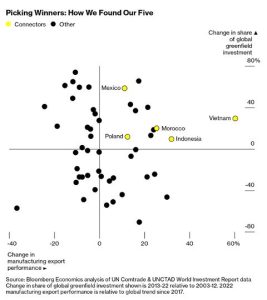Bloomberg’s ‘Connector Countries’ Emerge as Links in Fragmenting Global Economy
(Bloomberg Businessweek) — You may not have grown up playing with an Erector Set, but perhaps you had another building kit where, with patience and perhaps some parental assistance, you could bolt plastic rods together into colossal structures. The most important pieces were some of the smallest: the connectors. (They were also the quickest to disappear under the rug or into the vacuum.) Without those, you were just another frustrated mini starchitect.
We’d like to introduce you to a real-life set of connectors. That’s our name for a group of countries emerging as important links in a global economy that’s fragmenting into rival blocs. Listen to the rhetoric coming out of Washington and Beijing today, and you’ll hear a lot of “either you’re with us or against us” kind of talk. But not everyone is picking sides.
In collaboration with Bloomberg Economics, Bloomberg Businessweek took a dive into trade and investment data and found five nations straddling the new geopolitical fault lines: Vietnam, Poland, Mexico, Morocco and Indonesia. As a group, these countries logged $4 trillion in economic output in 2022—more than India and almost as much as Germany or Japan. Despite their very different politics and pasts, they share an opportunistic desire to seize the economic windfall to be had by positioning themselves as new links between the US and China—or China, Europe and other Asian economies.

The five are by no means the only economies straddling divides, but their geographic location and ability to grease trade has set them up as crucial middle grounds. These guys punch above their weight: They represent 4% of global gross domestic product, yet they’ve attracted slightly over 10%, or $550 billion, of all so-called greenfield investment since 2017. (The term describes outlays for new plants, offices and other facilities by a foreign company establishing or expanding operations in another country.) All have seen their trade with the world accelerate above trend in the past five years, according to an analysis by Bloomberg Economics.
Economists at the Bank of International Settlements looked at data from more than 25,000 companies and found supply chains lengthening as other countries, especially in Asia, became additional stops in trade between China and the US. Companies shifting supply chains away from China are often moving production to countries whose economies are already highly integrated with China’s, such as Vietnam. Mexico, where investment by Chinese manufacturers has ticked up noticeably in recent years, is also becoming an important link in US-China trade. So it’s not so much that the US and Chinese economies are decoupling—they’re just coupling in different places.
That doesn’t mean all is well. Even if there are winners in this new era, economists warn the overall hit to global growth from the disruption to flow of investment and trade will be negative, with poor nations suffering more than rich ones. For consumers and central banks, one unpleasant side effect will be more expensive goods—hence more persistent inflation—as the shuffling of supply chains drives up production costs.
Still, the connectors are proof that talk of the end of globalization is overwrought. Goods and capital still move across borders—even more of them, in fact. —Enda Curran, Shawn Donnan and Maeva Cousin











